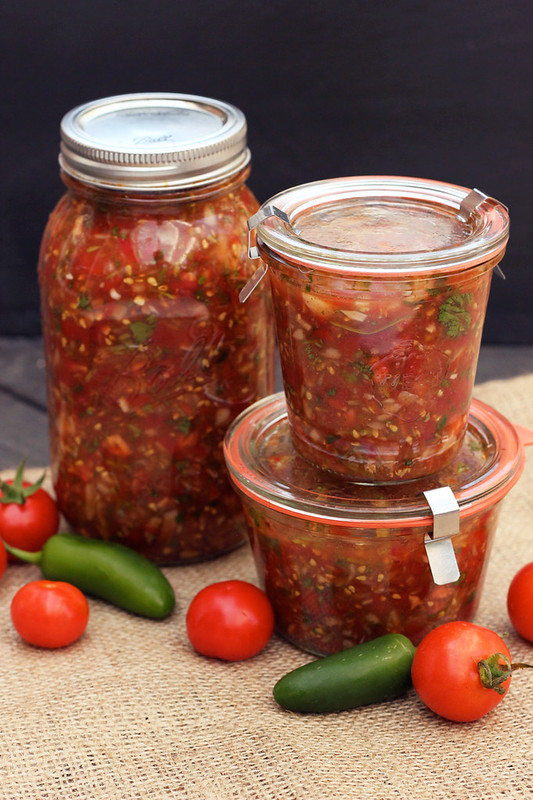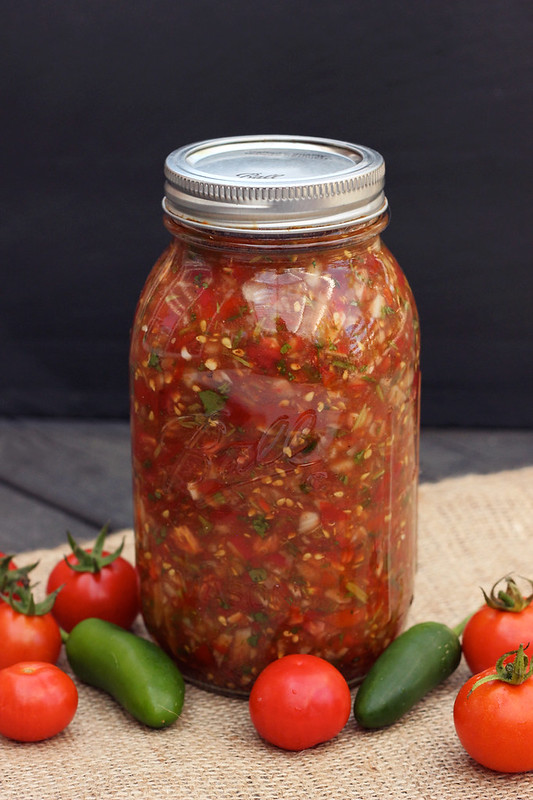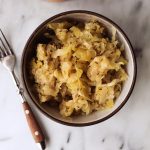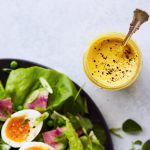First off, I know for many of you, your very first question will likely be “Why?” Why would you ferment salsa? Well, I suppose that could be asked about many things. Why ferment? Admittedly, fermentation and cultured foods is something I am newly interested in and I am still learning a lot about. So, I will just share some of what I have learned about why fermented foods are so good for us.
There is so much more to having a balanced and happy gut than we realize. It is now estimated that over 500 species of bacteria are present in our intestinal track with reports of 50 – 75% of our immune system activity residing there. In our modern world filled with antibiotic drugs, chlorinated water, antibacterial soap and pasteurized foods, we are killing off all of the good bacteria we need to maintain good health and digestion. If we don’t actively replenish this good bacteria that we need, we won’t get the proper nutrients out of the foods we are eating.
Why Ferment?
There are so many healthy enzymes that flourish and live cultures that are created when vegetables are fermented, creating an environment full of probiotics, enzymes and minerals which are important in maintaining healthy digestion and a healthy body. These live cultures, usually bacteria or yeast, that fermented foods contain, help balance the microflora are a little city of tiny organisms in our large intestine that, when working well, help digest fiber, protect us from things we’d rather not absorb like carcinogens, and keep the bowel healthy.
The probiotic good bacteria and enzymes in fermented foods help to populate our gut and intestines with Lactobacilli which are really important for healthy digestion. They also help to eliminate toxins from our body, so eating them will allow your intestines to detox, which is a really good thing! All of this beneficial bacteria (or probiotics) have also been shown to help slow or reverse some diseases, improve bowel health, aid digestion, and improve immunity! I am a huge proponent of taking a daily probiotic, which has changed the way my gut feels on a daily basis.
Besides improving digestion, restoring the proper balance in our guts, and helping us to pull more nutrients from our diet, fermented foods last longer in storage. This salsa can be stored in the fridge up to a couple of months. The lactic acid is what keeps it from spoiling. Lacto-fermentation is a popular option for fermenting and although I didn’t have any whey, I opted to just increase the sea salt, which works exactly the same and get it fermenting. If you wish to use whey, take the sea salt down to 1 tablespoon and add 2 tablespoons of whey. FYI there are even ways to make your own whey (say that 10 times fast) at home, just search around online for different recipes and how-tos.
Cultured raw vegetables that are created just by leaving them in airtight jars at room temperature for several days to ferment, this might just be one of the easiest and cheapest things you will ever come across to help use up those veggies and get some additional health benefits from, while you are at it. A common vegetable used for this is cabbage, to make homemade sauerkraut, but you can also add other vegetables like carrots or beets or radishes, etc.
This fermented salsa is simple to make and you can make the recipe your own, based on how you like your salsa and maybe what you have growing in your own garden. I had some great peppers from our garden and some fresh herbs from the farmers market, so I went to town making a spicy salsa, just like what we love. Feel free to tweak the herbs to what you like, add additional dried herbs and spices and other veggies, as you desire. This same recipe would work great unfermented, just add less salt or skip the whey. The differences in the taste of the fermented salsa versus the regular stuff are pretty subtle, you will notice the fermented salsa is a tad bit of tang and fizziness, almost a tad hint of an alcohol-y flavor, that I really like. I have served it to quite a few people, and it was well received by all, jars of this have disappeared fast around here. I have to thank Tasty Yummies reader Jaya Lila Ramey for her tips on fermenting salsa, she made it so much easier for me to just dive into this fermenting process, unintimidated.
Other examples of fermented foods are miso, kombucha, kefir, yogurt, kimchi, pickles, etc. If you are looking to experience some of the many benefits of what we’ve discussed, it is important to eat fermented foods regularly. This fermented salsa is a wonderful way to do just that. It is great with your favorite chip or cracker, on top of a salad, eggs, steamed veggies, soup, etc. Heck this salsa is so good you can just eat it with a spoon. A good tip to keep in mind too, fermented veggies are particularly good to eat with starches and proteins, as it will help you to digest these foods better.
What are your experiences with fermented foods? What benefits have you noticed? If you like fermented foods, what are your favorites?
[print_this]Fermented Salsa – Gluten-free + Vegan
- 2 – 3 lbs of organic tomatoes of your choice, I used heirloom cherry tomatoes from my garden
- 1 large onion, I have used both red and white, both are delicious choices
- various, chile peppers – quantity and types, your choice. We like spicy so I went with 2 serrano and 1 jalapeño (you can also use bell peppers if you like your salsa mild)
- 3-4 garlic cloves, minced
- 1 bunch of fresh cilantro (If you don’t like cilantro add in oregano, chives, etc)
- Juice of 2 limes, or 1 lime and 1 lemon, or 2 lemons
- 1 1/2 – 2 tablespoons sea salt*
- Dried spices to taste, if you’d like – I added some cumin, chipotle and chile powder
Add the tomatoes to your food processor and pulse them a few times until they are broken down to the size you like. I prefer my salsa a tad chunky. Place the tomatoes in a large bowl. Add the roughly chopped onion, peppers, fresh herbs and dried spices to the food processor. Pulse a few times until everything is chopped to the size you like. Add these to the large bowl. Obviously if you don’t have a food processor, you can just chop all of this by hand.
Add the fresh squeezed lemon and/or lime juice and sea salt to the vegetables. (Add the whey now if you are using it.) Toss everything around until it is well mixed. Pour into quart sized or smaller clean mason jars. Leave some room at the top, don’t fill it all the way up. Cap tightly. Leave on the counter for 2 to 3 days. Transfer to the fridge or cold storage.
This salsa will keep up to a few months in the fridge. I have read up to 8 months, actually. The flavors will actually intensify over time.
* If you are using whey use only 1 tablespoon of sea salt and add 2 tablespoons of whey. [/print_this]














95 Responses
Sounds great! Does it taste different?
Thanks Kristin. I actually talk about the slight differences in the taste in the article right up there 😉
Thanks for the reply! I completely missed it…..
This looks great I will try it this fall. I do make Kimchi and have for years. The same benefits and adds so much flavor to asian recipes like stir fry and fried rice.
Beth,
I discovered fermentation a few month ago and have been making fermented salsa, ketchup, mayonaise and kefir and yogurt! They make my belly feel so good. I am excited that you have discovered it as well and I look forward to seeing fermented foods appear in your always-delicious recipes!
Yum all of those goodies sound amazing!! I have made my own kombucha before, but that is as far as fermenting went for me. Until now. I cannot wait to play some more 😉
I am thrilled to hear of your new interest in cultured/fermented foods, because I am right there with you! I just ordered milk kefir grains and am so excited about the possibilities! I hope to replace my daughter’s yogurt with kefir (milk, coconut, almond milk). I’m also getting some water kefir grains from a friend this week. I can’t wait to see more fermented recipes here! 🙂
I am also excited to try out water kefir, but I just haven’t had the time. I need to have an extra day each week for all the things I want to accomplish in my kitchen 😉
Hi Cindy, Have you tried using water kefir instead of whey in fermented recipes? I am wondering if it makes a good fermenting starter in place of whey. I make water kefir and drink it every day. Thanks, Karen
I have not used water kefir itself as a starter, but I have used water kefir grains and they work very well for sauerkraut – about a tablespoon (1/2 at the bottom of the jar and 1/2 about halfway up) per quart jar really speeds up the fermentation process.
I used them for coconut milk yogurt as well, but I apparently used too much (about 2 tablespoons for one quart) as I nearly had an explosion about 18 hours later (I had a “yogurt volcano” when I opened the jar and lost about half a quart) and really didn’t care for the “kefiry” flavor the grains imparted into the yogurt.
Love the jars without the metal lid. I do not make my own fermented foods but like you I have heard they are good for the gut. I am not a fan of the salt that seems to be so prevalent in fermented foods that I have tried.
Have a beautiful day!
Aren’t those jars great? Fermentation can be done with out the extra salt, using whey or other starters. Google around, it is totally possible.
Hope you have a lovely day, too!
I am loving the looks of this recipe and am going to try it. I do have a question though. The instructions say to cap tightly and then leave on counter for 2-3 days. Should that not be cap loosely for the counter time to allow escape of gas and extra fluid? I’m asking because sauerkraut and fermented veggies require the lid to be loose for the first while and then the lids are tightened when put into storage.
When I have my jars on the counter for the initial ferment, I put them in a glass baking pan to catch escaped liquid. Saves a mess to clean up.
My favorite ferments: sauerkraut, fermented veggies, and have hard apple cider on the go.
I have to be honest that I am not sure why to cap tightly versus leaving it open. The reader I spoke with who makes it and EVERY other fermented salsa recipe I saw online said the exact same thing, too. I will have to do a little more research as to why that it and get back to you. Wow hard cider? Now I am intrigued 😉
Thanks Beth. The only thing that I can think of is that the tomatoes don’t give off as much gas (or liquid) as the sauerkraut and other cruciferous veggies. (FYI: if doing sauerkraut, have loose lid. If not you will have an explosion) Traditionally sauerkraut is done in a crock, but I like using the jar method as it’s less work.
I have the book “Fermented: A 4 Season Approach to Paleo Probiotic Foods” by Jill Ciciarelli and her recipe indicates a loose lid for the first few days. By the way, her book is worth a snoop. I’m using her method for hard cider (both wild and controlled) and there are a few other things I want to try such as beet kvass and fermented hot sauce.
I’ve been making my own Kefir for a little while in a bid to help my stomach. I use it in everything :). I also use it as a face mask after reading your probiotic mask post and OH Wow my skin looked amazing and I am seeing the difference with my wrinkles.
A really interesting article, thank you
I really need to try kefir!! So glad you enjoyed the probiotic mask, I have had such great results with it. Thanks for your comment.
This looks wonderful!
Thanks Sue.
[…] Tasty Yummies shared Fermented Salsa […]
Trying this recipe tonight!! I’ve begun fermenting foods this summer. You might read up on using pickl-it jars. From what I’ve read, they aren’t a true and safe anaerobic ferment without something like a vented jar and can pose health risk if fermented in just a regular jar. Thanks for the recipe!
Delicious recipe! (I tried it over the weekend, and I just opened the first jar tonight.) One thing to add, though: Because the fermenting process releases a lot of extra gases, I think it’s important to leave more space than you would for putting something like jam in cans, or even unfermented salsa. My jars’ lids swelled up, the jars leaked a bunch of liquid, and then, when I opened it, about 1/4 cup of salsa burst out of the top.
My reply should say “jars”, not “cans”.
Wow really? I didn’t have any issues like that at all. Maybe it is different for everyone. I will edit the recipe to include that note. Thanks for sharing. Quick question, did you ferment with whey or salt?
How weird that no one else had that problem! I imagined that the gasses expanding was fairly ordinary . . . oh, well. I fermented with salt, and because I don’t measure out ingredients exactly and was straining out the juice from some very, very juice tomatoes, I may have added too little – or too much, hard to be sure.
Fermenting is fickle! Everything from room temperature to how much natural yeast is on the vegetables make a huge difference in the final product. Organic produce ferments better then conventional. And over scrubbing the veggies removes bacteria beneficial to fermentation. Direct sunlight and an overly warm environment speeds up the process. There’s a huge learning curve which I’m still learning 🙂
[…] Kombucha //Fermented Ketchup //Homemade Kimchi //Fermented Salsa //Homemade Coconut Milk […]
Hi Beth,
Fermented foods are excellent for a healthy gut. I will try the recipe but is 2-3 days outside the fridge enough to ferment? I normally leave Sauerkraut (http://naturalhealingcyprus.wordpress.com/2013/05/20/simple-sauerkraut-recipe/) 2-4 weeks out of the fridge depending on the weather.
So excited I found this! I have found some recipes for fermented salsa but so far all have required whey (which I can’t have) or brine from sauerkraut, which I haven’t tried yet, so thank you!
I make water kefir regularly and kombucha as well but haven’t ventured into the condiment side of things, this will be my first.
Thanks for sharing!
Beth,
Great Recipe!
I love seeing people discover the health benefits of cultured foods!
I try to share on a daily basis the benefits of saving the bounty of food we enjoy in the U.S.
I also tell folks to find and participate in their local CSA’s (Community Supported Agriculture), to help return our nation to its once pristine and natural flora!
Thank You so much for being one more person that understands and promotes healthy living!
Keep up the good work!
For anyone having issues with gas building up a simple solution is to “burp” anything you are fermenting once or twice a day. Simply unscrew the lid slowly and just enough to release the pressure. You will hear the gas hissing out. When it’s done, screw it tight again.
Do you still have to burp it once moving it to the fridge? Or is that just for the initial few days on the counter?
So I made a batch in late August and after a few days of fermentation on the counter, I stuffed my jars into the back of the fridge. Just opened a jar today – 5 months later and I had gas build up in the jar, which – when opened – caused the salsa to bubble over the top and spill into the sink. I mixed the rest and tasted the salsa and it had a noticeable “fermented” tang to it. I wasn’t sure if it was still okay, but I’ve left sourdough starter in the fridge for weeks at a time, and lactofermented pickles for months and months. It’s watery, but SUPER tangy – and I just can’t go back to purchased salsa. I gobbled it up with some corn chips and am glad I have a second jar waiting for my next craving!
[…] Fish Sauce – Nourishing Joy Homemade Lacto-Fermented Ketchup – Suzy Homemaker Fermented Salsa – Tasty Yummies Fermented Mustard – Eating Rules Fermented Hot Chili Sauce – […]
Can I use Kosher Salt instead of Sea Salt? Anyone? Thanks!
Is the “whey” a special starter whey or just plain protein whey that you would make a drink with? Thanks!
I see that whey is mentioned as ” if using whey add at this time” but nowhere in the ingredients is it listed, what am I missing?
My bad!!! Of course I saw the whey notation after my comment. Have gotten sone helpful suggestions by reading other comments.
Fantastic post. I really got into fermenting foods a couple of years ago and have been trying anything and everything ever since and can’t wait to try this. I am really enjoying your blog and salsa looks great!
When making sauerkraut, I store the jars in the basement in a dark, cool place rather than in the refrigerator. Is this okay with the salsa? I really want to try this method, because until now I have not found a safe way to can homemade salsa without using a store-bought mix.
i thought on this fermentation that you had to have air get into the jars?
not to have the lids on tight?
can u do this in a large crock then after it ferments, put in jars then water bath?
Could this salsa be canned?
probably yeh, but I have ZERO experience canning sadly, so I am not the person to ask. But, I really don’t see why not.
shirley,
if you “can” this salsa, it will kill all of the beneficial bacteria that you’ve spent time culturing. if you want canned salsa, you should use a recipe out of a canning book. once boiled in a water bath canner, the veggies will no longer be raw and the friendlies will be dead 🙂
I’ve been reading a lot about fermenting foods, trying to include more probiotics in my diet. I haven’t seen a salsa recipe before. Looks very interesting and I can’t wait to try it.
From my reading, I understand that whey and salt have different roles in the process.
Whey (from yogurt, buttermilk, or milk kefir), kefir grains, brine from a previous ferment, or other cultures help the fermentation process proceed faster but can limit the variety of probiotics in the final product.
Salt’s job is to kill off the bad bacteria, allowing the good bacteria to go to work. However, too much salt will affect the good bacteria as well and slow down the fermentation process.
“Burping” the jars every day will prevent the spills, messes, and blow-ups.
Thanks again for the recipe.
it’s also my understanding that the salt helps keep the veggies crispy.
I’m a culinary coward … how do you know if it’s fermented or has simply gone bad? We don’t have air conditioning, so during summer, my kitchen will routinely be 90+ degrees most of the time. I keep very little “stock” in my pantry because of this so how would this heat affect the safety of trying to ferment salsa?
Paula,
The actual fermentation process is only a few days; once it’s bubbly, it has to be refrigerated.
sorry, somehow part of your question didn’t register in my brain! i keep my air off a lot and i’m in north florida; i haven’t had any problems with the fermented foods. they probably just ferment a little faster.
If I follow this recipe with 3lbs of tomatoes, how many quarts will it make? This will help me know how many batches to prepare.
Is the whey necessary, because it is not in the original recipe?
Thanks,
Lisa
I just made my third batch of fermented salsa and I just panicked as I thought my jars were going to explode as the lids were being pushed out, liquid was seeping out of the jars and the contents were separating more than before just after two days. I made a double batch and was very sad to think something went wrong. Thank goodness for all these comments, I think my salsa actually fermented this time (and possibly did not last time)! When I opened the jars the contents actually expanded 1-2″ out of the top. The salsa does taste different from last time but still tasty. Looking forward to the health benefits and happy that all may hard work didn’t go to waste.
hi, I tried this recipe and I see little specks of white mold at the top. 🙁 did I do something wrong? I followed the recipe. I only see very tiny bubbles.
So I tried this. It tastes good, but too salty. Interestly enough I had an explosive bathroom visit after eating this , twice. Which is probably a good thing. But , my question is, how to make it not so salty?
Hi Jenifer,
If you’re using an anaerobic vessel with an Airlock, you can use far less salt, and no whey. In The Probiotic Jar, we need just a little less than half a teaspoon (without whey) in more than a quart of salsa. (1 Liter is over a quart). That’s cutting the salt down a lot from 1 1/2 to 2 TBS. Although it is unclear how much this recipe will make, even if it is a 2 quart batch, that is still less than 1/3 the salt. If it’s a 1 quart recipe, then it’s less than 1/6 the salt.
Have you ever added or used tomatillos? I’m thinking of using them along with the red tomatoes.
I made this recipe, and saying the difference in the taste of fermented vs. non-fermented is quite a bit of an understatement. I made one batch of this and fermented it. Then I made two more batches, and they sit in my fridge un-fermented. The Fermented batch is hardly edible to us. It’s Extremely Fizzy, and it tastes identical to a lime-a-rita or some very bubbly lime flavored soda if we eat it right out of the jar. I wonder how me and the husband are going to stomach it; we may just toss the fermented batch out. I notice if I sit the jar of fermented salsa out and shake the bubbles out, the longer it sits, the more it tastes halfway normal. Now, a lot can be said about the salsa before fermentation. Pretty much the best salsa ever. Absolutely delicious. My recommendation to anyone going to make this is skip fermentation, and you won’t have to worry about the (refrigerator) shelf life because it won’t last long. If you ferment it, well, you will need an 8-month or so time frame to stomach that nastiness. We too take pro-biotics, in pill form and we drink kefir, but Good God this fermented salsa no longer tastes like salsa post-fermentation.
Christina, there is no accounting for personal taste, especially when it comes to fermenting. It is also not an exact science, there are many variables that can affect the fermentation time and the taste. Heat, the time you give it to ferment, the vegetables that you use, etc. I love the fizziness, as do many others, some people don’t, my husband doesn’t. Fermented foods are an acquired taste. The fermentation here isn’t just about the taste, in fact that is secondary to the benefits of the fermentation. If it’s too fermented for you or someone else, you could give it less time to ferment and there will be less fizz and less intense flavors. I am glad you liked the salsa without the fermentation and happy to hear that you are getting all those good probiotics elsewhere. Thanks for taking the time to comment.
I especially like that it safely lasts up to 8 months. As a single, food spoils much too easily for me.
I realize this article is old, hopefully you can still answer my question though 🙂 I just made this salsa yesterday & it’s sitting in a dark place to ferment as we speak. My question is, do you not use any kind of weight to keep the veggies down under the brine? Everything i have read about fermenting states veggies must remain under the brine in order not to mold. I’m new to fermenting & must admit, I’m terribly worried about poisoning my family!
Kristin, with the salsa there is usually so much liquid that the veggies stay submerged. I have never had to weight it down. Don’t worry about poisoning your family, if you always trust your instincts, I can guarantee you would never serve them something that isn’t right. Mold and bad smells would certainly be present with bacteria, these are things you definitely couldn’t miss!
Don’t post an honest review! The blogger will gleefully delete it, and you will still be subscribed to BS comments that are posted after your honest review is deleted!
Good morning Christina! I actually didn’t delete your original comment. I get SOOOOOOO much spam commenting on this website that many of the comments from real people are flagged as such by the software that I use. I am so glad that you came back to let me know that it was missed. I went into the spam folder, found your honest review and it has now been published, so fear not!
I am sorry it didn’t work out for you.
Excellent. Thank you. We did 1 TBS chili powder, 1/2 TBS cumin and it is excellent. So far seven (7) 32 oz jars. Ran out of cilantro, so we will wait another day or two before making more
Great recipe! Started a double batch 3.5 days ago and I haven’t noticed any bubbling activity… Tasted it and it tastes great, but doesn’t have the fermented flavor. I fear I used too much salt for this cooler point in the year(3.5 tablespoons for a double recipe/gallon). Should I just leave it out longer until it seems active? Thanks for your help!
I’ve made this fermented salsa before and fermented a few jars, which I love. So I made a huge batch and left out enough for just a couple of jars to ferment and froze the rest of the unfermented in bags, to take out of the freezer to ferment as neeeded, but I can’t get it to ferment. My question is, does freezing the ingredients before fermenting cause a reaction of some kind to prevent fermentation? I used salt not whey.
I have been making salsa for several years. I recently went through extensive testing with my product to be able to sell my salsa to the retail market. The certification process is quite strict and salsa must be made within a specific pH (acid) range or you won’t get certified. (This process took me a whole year of testing formulas and sending them in for lab testing .) The acidic environment helps ensure that botulism can’t grow.
The acid in your recipe isn’t very high. I’m very curious to know how this is a safe product? I would LOVE to have fermented salsa! We eat it almost daily so it doesn’t last very long. But this is an interesting alternative. Looking forward to your insight!
Acidity grows with the fermenting time. It would be hard for her to quote an accurate acidity unless she used a litmus paper or something along those lines
I just put up your recipe in 2 airlocked quarts. I didn’t see your comment about reducing the salt when using airlocks until after I made it. It tasted pretty salty fresh, so I am sure it will ferment and not spoil. I am planning to taste test in 2 days, and will give it another day or two if it hasn’t started to bubble. I will try to remember to post back my findings.
I find the saltiness dissapates as the ferment completes and the flavors merge
I ferment lots of veggies in salsas, pickles and marinades for fish and meat. If you have some kombucha that has gone to far,it can be used to start your ferment with a little salt and sugar. Try a carrot cucumber and ginger pickle, with steamed rice
I’m confused about the whey. There is no whey listed in ingredients or a measure. Why would whey be added?
hi this sounds grate i am going to try this but what is the ( whey ) it is not in the list of ingredients what is it used for i am not familiar with this is it a ( spice or a herb ) where can i get this
thank you for this recipe
Can’t you seal the jars in a bit bath, so they last longer without refrigeraton
what amounts of the dried spices did you add? Thanks
Can you freeze this or seal with a hot bath process & Shelf store?
Total epic fail. I followed your recipe to a T and ended up with 3 quarts of mold. Thanks for wasting my time and money!
I am sorry to hear it didn’t work for you Ashley, fermentation is a very fickle and a not-so-guaranteed process with soo many various factors. Mold is caused by bacteria which can be due to many different things. Are you absolutely certain that it was mold and not simply a white film, which can be a safe to consume yeast? Exposure to oxygen encourages mold spores to form. Were your jars tightly capped? Temperature can also affect mold, was it a hotter than usual time? A temperature of 65° to 70°F is ideal. The quality and freshness of your vegetables can also affect mold growth. There is nothing wrong with this recipe and the instructions, I have made this many times as have many others. Sadly this is simply how fermentation goes, sometimes. I hope this fail doesn’t keep you from experimenting with ferments in the future.
Here are some great resources to help troubleshoot in the future:
http://www.culturesforhealth.com/learn/natural-fermentation/vegetable-ferments-mold/
http://www.culturesforhealth.com/learn/natural-fermentation/fermented-vegetables-troubleshooting-faq/
Can I can this recipe?
you could…..but why would you want to? it would then be like every other canning recipe out there for salsa. this recipe is living food full of probiotics which would be killed during the canning process. fermented foods and beverages are wonderful for your digestive system among other things, but only if they are kept “alive” 🙂
Couldn’t have said it better myself Cindi 🙂 Thank you.
thank you beth! i have a tendency to jump right in 🙂
I love it. I welcome it. Keeping up with comments across all the social channels and here could be a full time job in itself. I miss a lot and just can’t get to them all – so I say jump on in 😉
I ended up adding a ton of peppers like 25+, Santa Fe for heat mostly and Anaheim, Rocotillo, Padron, Cubanelle, all green ones, and used yellow tomatoes. and cilantro is dead here so i used some moss parsley. Then i 3d printed myself up a fermenting lid. :} thanks for the rec
Just made this today! Does the salt taste subside? As of right now it’s too salty to eat. This is my first time with fermented food.
Can you water bath can this? I’d like to make large quantities but not sure if it would survive the heating process.
I have never tried, but just know that the heat will keep any beneficial bacteria created during the fermentation, so it’s basically a waste to bother fermenting if you plan to preserve in a water bath. You also have to take pH into account when canning, so you would want to look into that, as well. Sorry I cannot be of more help.
Thanks for the recipe! Today marks the 4th or 5th time I’ve made this salsa. My husband and I love it!
What would be the recipe to make a gallon of the Fermented Salsa?
Can this method be used for vegetables
I blanched my tomatoes for 3 minutes so I could peel them. Is my salsa now ruined?
Love this recipe! I use a tablespoon of my fermented garlic brine as my starter and it works great- no whey needed and it’s not over salted!
Help! Did I completely miss on how the actual fermentation Works? Do you add a probiotic or is it the sea salt that actually makes it ferment?
My husband don’t like chunky salsa. Will it still ferment if it is in liquid form or does it need the chunks of veggies to work?
yes, it should still ferment if it is more blended and less chunky